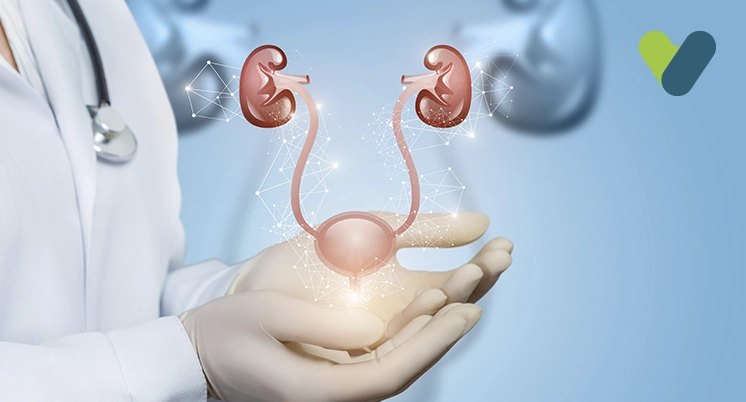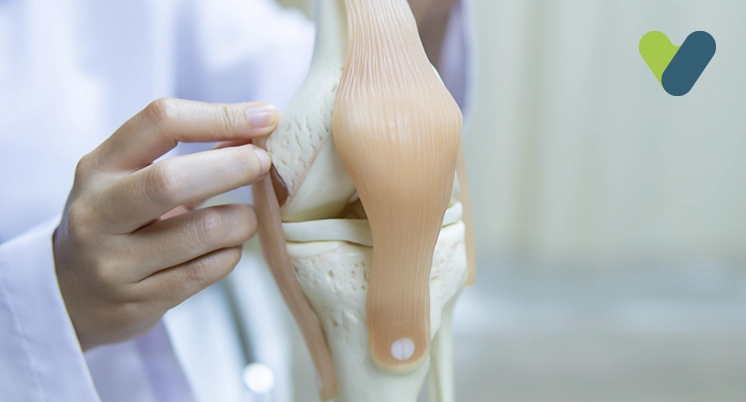Bladder cancer occurs when a tumour (a development of unwanted tissue) grows in the urinary bladder. The bladder is in the lower part of the abdomen, and its main function is to store urine made by the kidneys. It is a hollow balloon-shaped structure that has muscles that grow large to make space for urine. These muscles also help the bladder contract to squeeze out urine when needed.
The tumour in the bladder forms because the cells become abnormal and multiply at an unusual rate. The tumour can also spread to lymph nodes and other adjoining organs. There are also chances for the cancer to reach far away organs like the lungs and the brain.
The most common sign of bladder cancer is bloody urine. It is alarming to see blood in your pee, but you should see your doctor for a solid diagnosis. Bloody urine can also be a sign of some other medical condition, so it’s always best to consult a doctor for clarity.
There are several factors that can cause bladder cancer. The foremost is genetic predisposition; if you have a family history, you’re vulnerable to having this cancer yourself. Then your lifestyle choices, bladder issues like inflammation, smoking, and certain medications can be reasons as well.
Types of bladder cancer
Urothelial carcinoma, which is also referred to as transitional cell carcinoma, is a common type of bladder cancer. The cancer begins in the urothelial cells, which line the bladder surface. Because they change shape, urothelial cells are often referred to as transitional cells. These cells have the capacity to expand when the bladder is filled with pee and contract when it is empty.
Other, less common types of cancers that develop in the bladder are:
- Squamous cell carcinoma begins in the squamous cells, which are thin, flat cells on the inside of the bladder.
- Adenocarcinoma is a type of cancer that develops in glandular cells located in the bladder lining. The bladder's glandular cells produce mucus and other chemicals.
- The bladder cancer small cell carcinoma begins in nerve-like neuroendocrine cells. These malignancies typically spread quickly and require treatment like the one used for small cell carcinoma of the lung.
An alternate way of classifying cancer is:
- Non-invasive is the bladder cancer that has not reached the muscle layer of the organ.
- Invasive bladder cancers usually penetrate the deep layers of the bladder. These cancers are likely to spread to other parts of the body and are harder to treat.
Treating bladder cancer
Surgery is frequently used to treat bladder cancer. Based on the stage of cancer, doctors choose surgical treatments. For instance, the TURBT technique, which is used to identify bladder cancer, can frequently treat bladder cancer that has not yet progressed. Either the tumour is surgically removed, or a procedure known as fulguration involves high electricity to burn the tumour away.
Another course of action is a radical cystectomy. Your bladder and other organs are removed during this procedure. When a person's bladder is covered in initial tumours or has cancer that has spread beyond the bladder, surgery is required. The type of urinary bladder cancer surgery depends on the extent to which the cancer progressed. The bladder cancer surgery cost in India varies from 1.5 Lakh to 2.5 Lakh depending upon the severity of bladder cancer and the type of procedure performed.
Why is bladder cancer surgery/ urinary bladder cancer surgery done?
Most of the time, surgery is used to treat bladder cancer. The goal of this strategy is to eliminate as much cancer as possible.
Surgery for bladder cancer is frequently determined by the clinical stage of the tumour at the time of diagnosis. This involves how far down the bladder wall it is believed to have penetrated and if it has progressed outside of the bladder. Treatment options are also influenced by other factors, including the size of the tumour, the rate of cancer cell growth (grade), as well as a person's physical well-being.
The bladder cancer surgery alternatives mostly depend on how far along the tumour is.
Types of bladder cancer surgery/ urinary bladder cancer surgery
- Cystectomy When bladder cancer is aggressive, the entire bladder or only a portion of it may require removal through a procedure called a cystectomy. Most frequently, chemotherapy is administered before cystectomy. Any type of cystectomy is performed under general anaesthesia, which puts the patient in a deep sleep.
Partial cystectomy
A portion of the bladder is removed during a partial cystectomy. Since the bladder is retained in a position that allows you to urinate regularly, the procedure is known as a bladder-preserving operation.
General anaesthesia is used to perform a partial cystectomy. Above the bladder, the surgeon will make an incision in the abdominal region. A border of normal bladder tissue is dissected around the bladder portion containing the tumour.
Radical cystectomy During a radical cystectomy, the entire bladder is removed, along with any nearby organs and tissues. In men, the prostate, seminal vesicles, ends of the ureters, and occasionally a portion of the urethra are typically removed. . In women, the uterus, ovaries, fallopian tubes, cervix, urethra, and vaginal front wall can be removed.
General anaesthesia is used during a radical cystectomy. The bladder can be removed by the doctor through an abdominal cut during open surgery . The surgeon may also perform laparoscopic surgery in certain circumstances. With this procedure, the surgeon makes several small incisions before inserting an endoscope and specialised equipment for bladder removal. After the bladder is taken out, the doctor creates a new route for the patient to store urine and urinate.
- TURBT (Transurethral resection of bladder tumour) Tumours from the bladder are removed through the urethra during transurethral resection of the bladder tumour (TURBT). This procedure identifies, classifies, and manages bladder cancer. Because it's the most common method of bladder tumour testing, it's typically the first operation performed for bladder cancer. Initial bladder cancer that has not spread to the bladder wall's muscle layer may merely require a TURBT as therapy. To ensure that all cancer has been removed, sometimes a second TURBT is performed. Before undergoing further therapy for bladder cancer that has advanced into the bladder wall, a TURBT might applied to eliminate as much of the tumour as necessary.
Before a TURBT, a general, spinal, or local anaesthetic is administered. A cystoscope, which is a narrow rod with a light as well as a lens on the base, is inserted into the bladder via the urethra by the surgeon. The surgeon will next extract the tumour and a region of healthy tissue surrounding it using a special tool with a wire-cutting spiral that is sent through the cystoscope. To check for cancer that has spread into the bladder wall's muscular layer, some tissue from the bladder wall is also extracted.
A strong electric discharge (called fulguration) or a laser is used by the surgeon to burn the region where the tumour was extracted. In addition to help eliminate any leftover tumours, this surgery shuts off blood vessels that feed the tumour and help it grow. A tube might be placed in and kept there for several days following surgery. When the bladder is healing, this aids in the elimination of urine. Depending on your procedure, individuals might be discharged from the hospital the same day, or they might need to stay a bit longer.
What happens before bladder cancer surgery?
You meet the people on your treatment team and undergo physical tests before surgery. This pre-op evaluation often takes place a few days or a few weeks before a bladder cancer operation. The day before or the morning of the procedure, you normally check into the hospital.
Usually, patients stay in the hospital for one to two weeks. The type of surgery you have and how quickly you heal will determine how long you need to stay.
What happens after bladder cancer surgery?
- You will spend several hours in the recovery area once you are conscious and stabilized, and then you will be transferred to the urology surgical ward, where you will be placed in a hospital bed alongside your family.
- The facility is open for visits around-the-clock, and guests who want to remain the night can relax in reclining chairs. The nursing staff will start you on a purely liquid diet, and you'll get frequent examinations.
- After surgery, patients are advised to drink plenty of water and include some form of movement in your routine. The easiest way to do this is to walk around the room for starters.
- After your request to leave is granted, you'll get thorough discharge instructions to get you ready for your rehab at home. To ensure that people improve completely from the operation, patients are frequently followed up with a few in-home nursing appointments for follow-up from professional nurses.
What are the recovery measures after bladder cancer surgery?
- Bladder cancer can recur after surgery, so doctors advise testing around 3 months post-op. Then the testing continues every 3 to 6 months for 2 to 4 years. The frequency of your doctor’s visits will reduce if there is no indication that the cancer may develop again.
- Surgery to treat bladder cancer is a significant treatment, so rehabilitation might take some time. Bloody urine for the first 2 to 3 days is common and can continue for up to 2 weeks
- You'll have a tube in your bladder after a TURBT. When you leave the hospital, this might be taken off, but you might need to keep it in place until your initial follow-up session. After you leave home, the nurse will demonstrate to you exactly how to empty the bag and connect it so you can walk freely.
- You will need to keep your abdominal wounds dry and clean as you heal if you underwent a cystectomy and urine diversion. When you're able to take a shower or get the affected regions wet, your health professional will inform you.
- You will need to keep your abdominal wounds dry and clean as you heal if you underwent a cystectomy and urine diversion. When you're able to take a shower or get the affected regions wet, your health professional will inform you.
- Your activity level post-discharge will also be discussed with your healthcare professional. It is frequently advised to prevent lifting anything too heavy for a few weeks.


